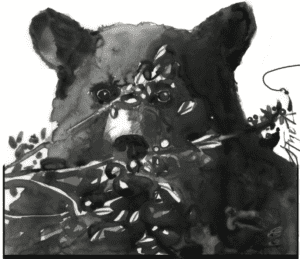By Meghan McCarthy McPhaul
Among summer’s many sweet offerings are wild berries. And among these, blueberries are my favorite. Years ago, I took to carrying large, empty yogurt containers in my car – and smaller vessels in my backpack – so I would have something to fill should I pass a good berry patch. My children became used to my meandering travels along back roads and woods trails as I foraged opportunistically.
During one picking spree, the kids and I heard rustling just downhill from where we were bent over the bushes, plucking berries and dropping them, a-la the children’s book “Blueberries for Sal” – kaplink, kaplank, kaplunk – into our buckets. I looked up to see the rump of a black bear not 30 yards away. That was a bit too reminiscent of Little Sal and her mother encountering mama bear and her cub in Robert McCloskey’s 1948 classic! We quickly retreated to the car, leaving the berry-munching bruin to that particular patch.

According to Arthur Haines, senior research biologist for the Native Plant Trust, 10 species of wild blueberries grow in New England. All but three of these are lowbush varieties, with the bushes typically growing somewhere between a few inches and a couple of feet in height. Of course, it’s not only humans and bears that eat wild blueberries; they provide food for a variety of wildlife throughout the year.
Pollinators, including native bees, visit the small, pinky-white, bell-shaped flowers in spring. Bears, rabbits, moose, and deer browse the foliage. A whole host of birds and mammals eat the berries, which ripen in July and August. Mammals include bears, foxes, raccoons, mice, and chipmunks, with birds such as turkeys, grouse, chickadees, catbirds, and thrushes also joining the feeding frenzy. Ruffed grouse also consume flower buds during the winter.
The berries I find in my forays – in roadside fields and along mountain hiking trails – are likely Vaccinium augustifolium or Vaccinium myrtilloides, both lowbush blueberry varieties common in New Hampshire. Regardless of species, the appeal of these berries lies mainly in their sweetness – typically sweeter than the cultivated, store-bought varieties. That is due to the foraged berries’ smaller size – from one-tenth to four-tenths of an inch in diameter – which affects both sugar concentration and the level of health-boosting antioxidants in these wild treasures.
“Cultivated varieties are larger, which means they have less ‘skin’ per unit of mass,” said Haines. “Most of the antioxidants are in the skin, so cultivated berries are less healthy to consume than wild versions.”
Those antioxidants include polyphenols, flavanols, and hydroxycinnamic acids, according to an entry in the first volume of Haines’ book series, “Ancestral Plants.” As outlined by Haines, the health benefits of eating wild blueberries range from helping to prevent heart disease, stroke, and age-related mental decline to fighting cancerous tumors and promoting improved night vision.
It seems unlikely that wildlife consider these benefits as they nosh in summer fields, but the animals that consume the berries help to propagate them. Despite their diminutive size, wild blueberries contain roughly 60 seeds per berry. According to a species overview of V. augustifolium by the U.S. Forest Service, robins and bears, especially, effectively disperse blueberry seeds over long distances in New England, and smaller mammals disperse seeds more locally.
The plants may also spread by rhizomes. These underground stems can expand into mats stretching many feet in size, and this growth characteristic allows lowbush blueberries to thrive in shallow soils. Wild blueberries prefer open, sunny areas and grow in a variety of habitat types, including mixed conifer and hardwood forests, upland bogs, sandy areas, and exposed rocky outcrops.
I am always happy to find them – whether in clumps of bushes along rocky paths near mountain summits, hidden amid the unruly growth of our fields, or in the roadside patches I’ve discovered over the years and return to each summer. There, I crouch down in the sun and pluck small, indigo-hued orbs from low-growing plants – some to eat now, some to store away for winter. Kaplink, kaplank, kaplunk. Into the bucket they go.
Meghan McCarthy McPhaul is assistant editor for Northern Woodlands. The illustration for this column is by Adelaide Murphy Tyrol. The Outside Story is assigned and edited by Northern Woodlands magazine and sponsored by the Wellborn Ecology Fund of the New Hampshire Charitable Foundation: nhcf.org.




